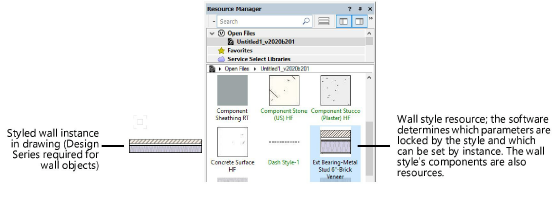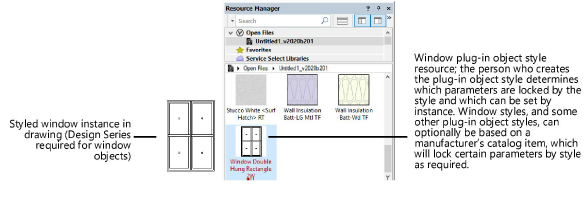
Vectorworks allows great flexibility in creating objects to add to a drawing and editing objects that are already inserted. Individual object instances can be created with unique parameters and inserted, or you can create a symbol definition or an object style that allows you to efficiently insert many identical or similar object instances throughout the drawing.
A symbol instance or an object instance is a single item that is placed in a drawing. Depending on the kind of object, an instance may be a unique object, with its own editable geometry and set of parameters, or it may be defined in full or in part by a definition or style. Within Vectorworks terminology, if an object is called simply by its name – a symbol, or a door, or a wall – that typically refers to an instance.
Symbol definitions and object styles define all or some parts of an object, so the object’s geometry/parameters are the same for all instances that use that definition/style. Vectorworks includes thousands of commonly used symbol definitions and object styles, and you can also create definitions/styles to meet your specific needs. Definitions and styles are resources that are accessed through the Resource Manager for use when placing object instances in the drawing; they can also can be shared with other users and in other files.
Although symbol definitions and object styles are similar, there are key differences:
● Symbol definitions are geometric; they establish the geometry for an object, and make it easy to insert many repetitive symbol instances into the drawing. Many symbols do not interact with other objects, apart from the ability to be inserted in walls.
● Object styles are parametric; they establish a set of parameters that are used to insert consistent object instances into the drawing. For many object styles, some of the parameters are locked by the style and must be the same for every instance, while others can be set individually for each instance and allow flexibility when needed. Some object styles, such as wall styles, predetermine which parameters will be locked by the style and which are editable by instance. Plug-in object styles, on the other hand, allow the user who creates the style to make that determination (see Concept: Plug-in object styles).
For some plug-in objects, the style is also defined by manufacturer catalog items (see Concept: Plug-in object styles and catalog items).
Symbol definitions and object styles interact differently with instances, depending on both the item type, and how the definition/style is set up.
● All symbol instances are based on a symbol definition. As the name suggests, a symbol definition completely defines the geometry of instances that are placed, and all symbol instances based on a particular definition have identical geometry. For most symbols, editing the symbol definition instantly edits all the instances based on that definition throughout the file. See Concept: Vectorworks symbols for more detail about the types of symbols and how they work.
● Unlike symbols, plug-in objects and other non-symbol object types do not have to be based on a style. They can be placed as a unique object instance with custom settings. Some, but not all, object types do allow the creation and use of styles that set the parameters for instances.
Most Vectorworks tools that insert objects, including plug-in objects, allow you to set default parameters using the Preferences button on the Tool bar, which apply to all subsequently placed object instances of that type until new defaults are set. This makes it easy to insert multiple instances with the same settings; however, this is not the same as creating and using object styles, which are saved as resources.



~~~~~~~~~~~~~~~~~~~~~~~~~